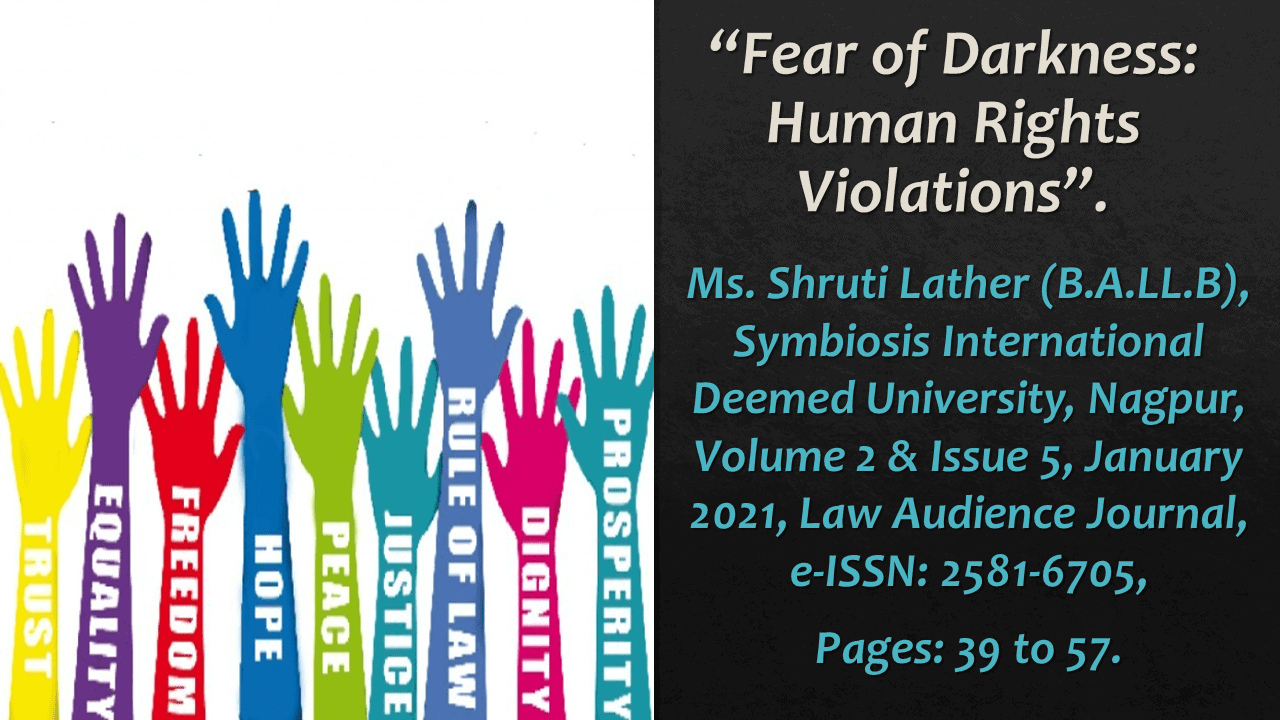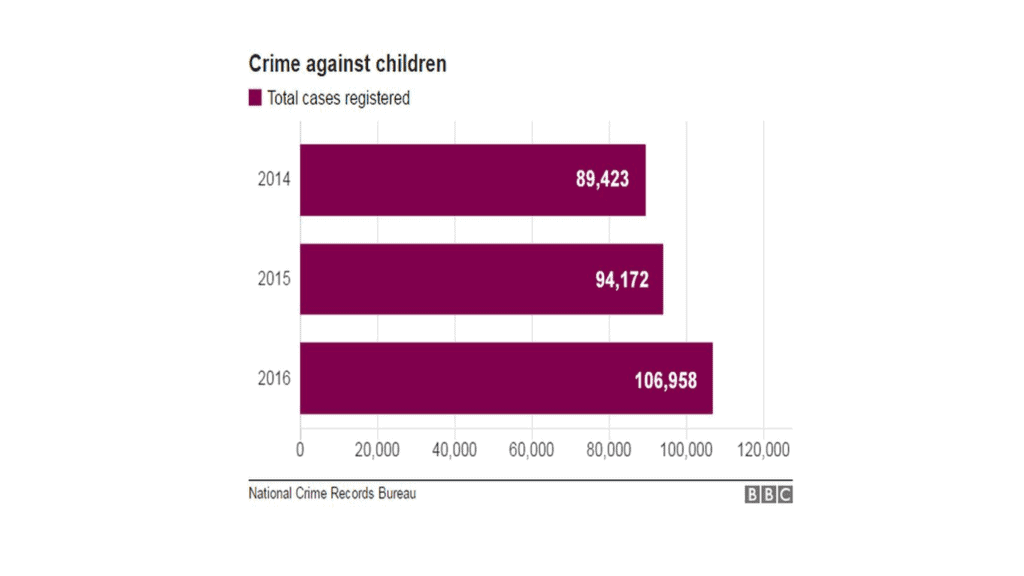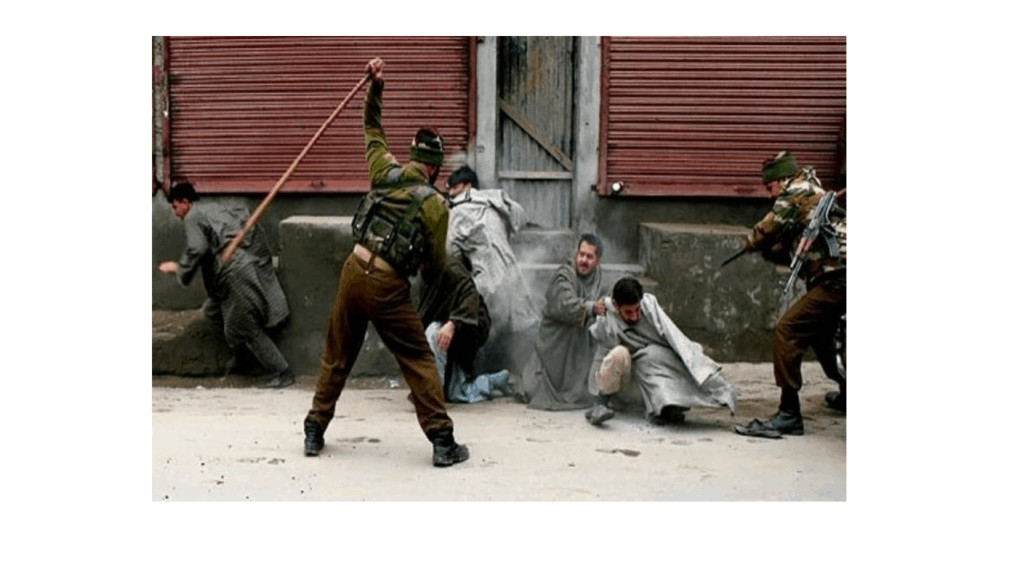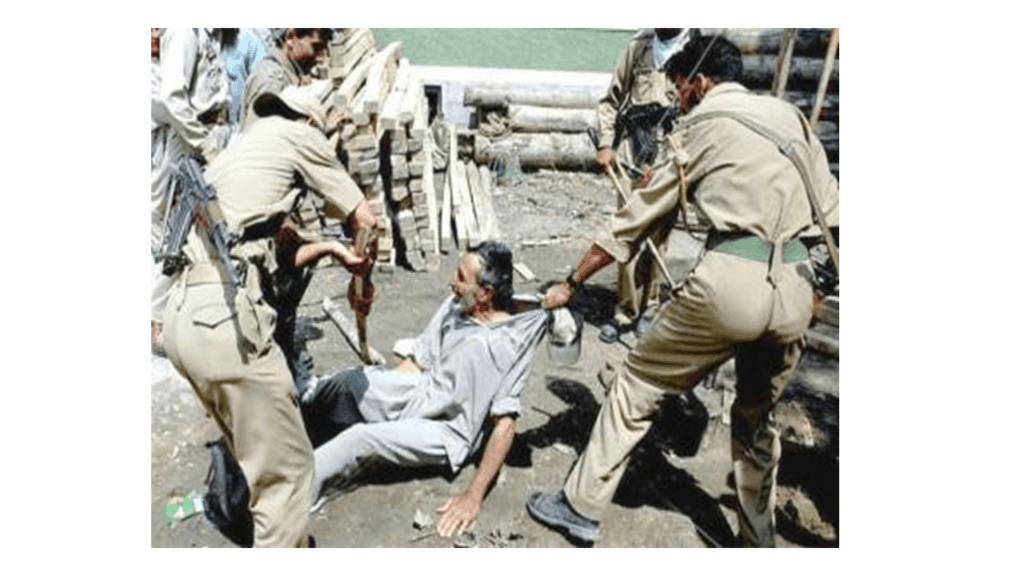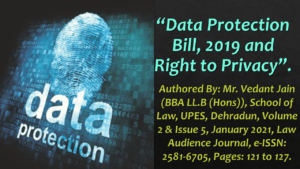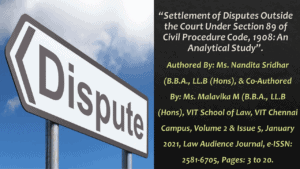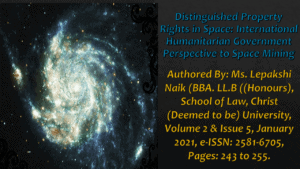Click here to download the full paper (PDF)
Authored By: Ms. Shruti Lather (B.A.LL.B), Symbiosis International Deemed University, Nagpur.
Click here for Copyright Policy.
Click here for Disclaimer.
ABSTRACT:
“In this research paper researcher has discussed about the Human Rights that has been established in India and the different fundamental rights that are being offered to the people. Each and every right is being interlinked that has stated the people to be fair enough to be treated and get the platform for exploring their rights like Freedom of Expression and Freedom of Development. However, it has been found that there are increased numbers of violence and wrong treatment that are carried forward on the individuals that have led the people to make a question on the Constitution and the human rights that are enforced. The research paper has broadly discussed with reference to case laws of the different violence that has been surveyed in the period of 2018 and 2019. The importance of UDHR has also been written in the research paper showing the contribution of India to it.”
Keywords: Human Rights, Violation of human rights, Constitution, Fundamental Rights, UDHR, Judiciary.
I.0 FUNDAMENTAL RIGHTS IN INDIA:
I.I INTRODUCTION:
“Fundamental Rights” is the key term that Parliament in India and the Governmental bodies mainly focuses on to ensure that no wrong justice is given to the citizens. It is a faith among the citizens that the government will take measures in any circumstances to protect the fundamental rights that protect the citizens from any kind of illegal activities[1]. Despite the strong notion in the Parliament and with large talks on the fundamental rights of the individual, still, there are cases that have turned against the fundamental rights of human beings and have created a wrong concept in the minds of the human being[2]. This legal research paper will analyze the importance of the fundamental rights and the actions that are taken by the Government to ensure that justice is bestowed on the victim.
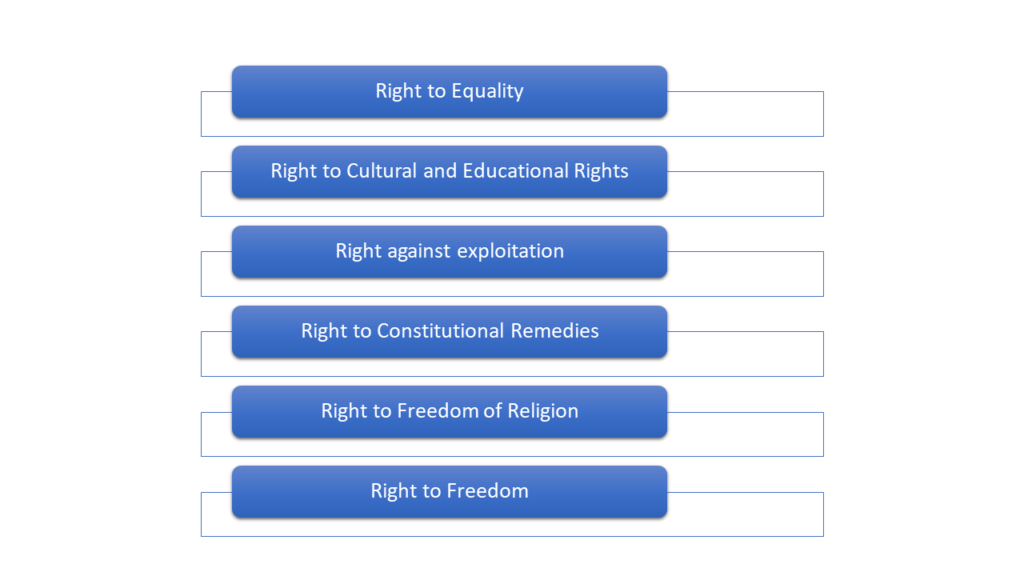
Figure 1: Fundamental Rights in India
(Source: Shruti lather)
From the beginning, the Indian Constitution has been representing as the guardian taking care of the citizens as his own children and therefore has legislated different provisions that will ensure that they can walk with freedom. The Constitution has enforced all the rights through the Court that acts as the legal bodies giving justice to the individuals. Just like the American “Bill of Rights”, it has been evaluated that the “Fundamental Rights” hold the same position in India. Part Three of the Constitution mainly talks and discusses about the fundamental rights.
Constitution has the major function of controlling the governmental activities but also ensure that the citizens enjoy democratic rights. In the last 50 years, a lot of changes has been amended in the fundamental rights since violations of the rights have appeared largely. It has been identified that due to the illegal activities, wrong decisions and also vulgar activities, the Constitution has been in a position to change the decisions and amend the decisions. Standing in the 21st century, it would be essential to identify the major changes that the Constitution has done to the fundamental rights and focus on the violation of the rights.
Part 3 of the Constitution of India has spoken and discussed about the various rights that are entitled under the provisions such as the following:
- Right to Equality
- Right to Cultural and Educational Rights
- Right to Freedom
- Right to Freedom of Religion
- Right to Constitutional Remedies
- Right against exploitation
Article 21 states that every person will enjoy equal rights on the personal liberty and it will ensure the protection of the personal liberty and the life. Fundamental rights have the core enforcement of the rights that will protect the citizens from being deprived of any facilities or provisions[3]. Henceforth, people have good faith towards the constitution of India but recent upheavals have changed the constitution to make certain amendments.
To offer remedies to the citizens against injustice, the Supreme Court and the High Court have the rights to issue orders and writs that will protect the rights of the individuals. Special orders that Courts can issue such as the Mandamus, Habeas Corpus, Quo Warranto, Certiorari and Prohibition which will protect and offer remedies to the citizens.
I.II CONCEPT OF FUNDAMENTAL RIGHTS:
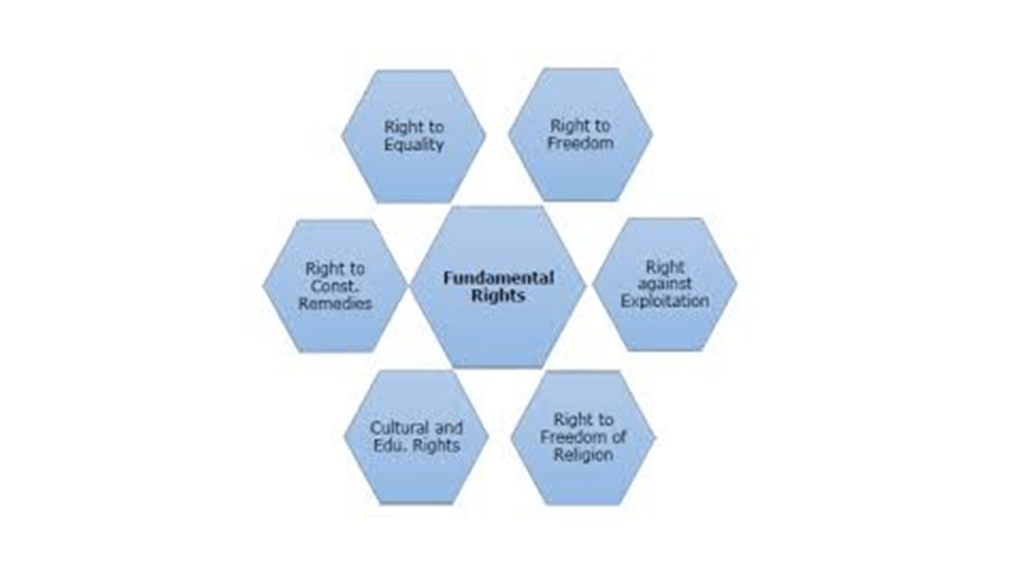
Figure 2: Fundamental Rights of India legislated by the Indian Constitution
(Source:[4])
It is to be noted that after the amendment that was made for the 44th time, the Right to Property has been introduced. From the start of the 17th century, it has been assessed that human thinking is undergoing certain changes where they have developed a belief that man has certain inalienable and natural rights[5]. By studying the different principles of human rights and the fundamental rights, it is studied that it has obviously seen a dramatic change in the policies and principles as laid down but yet hidden. In India, there are a lot of commotion that are heard about the activists and the common people speaking of human rights and its violation. It is the responsibility of the government and the Courts as entitled to protect the rights of the people. Article 15-16 has clearly laid down the fact that no one will be discriminated based on the religion, race, place of birth or other considerations. Special provision as stated by clause (2) of article can make sure that is legislated for their benefit. In all respects such as employment or appointment to any office, citizens will be given equal rights and positions will not be determined based on race, sex or religious backgrounds. Article 18-19 has stated that people will have the right to move about freely in any place without any kind of objection. From the discussion, it is vigilant that fundamental rights are enforced to protect all citizens from an unfair treatment and at the same time to assure that the people are not being prohibited from any action.
I.III VIOLATIONS OF THE RIGHTS IN INDIA CARRIED IN 2018 AND 2019:
Discussing about the fundamental rights, the increased numbers of the rape cases have been an example of the violation of the human rights that states men and women to have the equal status and liberty. Lack of witnesses in such cases and the victim-blaming is rampant in attitude that has brought to the question of the human rights. Nevertheless, the Sexual Harassment of Women at Workplace Act of 2013 has been established yet it has been a failure since reports have come to injustice being delivered[6]. Decades have shown that India has been on the right track in respect to the protection of the human rights and ensuring provision of fundamental rights to everyone but it has been a failure under the leadership of the incumbent government.
Figure 3: Crime against Children in India
(Source:[7])
From the figure above, it is quite transparent that protection of the human rights like the quality fostered on women is just a story and nothing else. Recent event on the attacks on the Kashmirian’s have been a phenomenal example of violation of the human rights where every Kashmirian’s are facing issues and mainly are suffering from loss of identity.
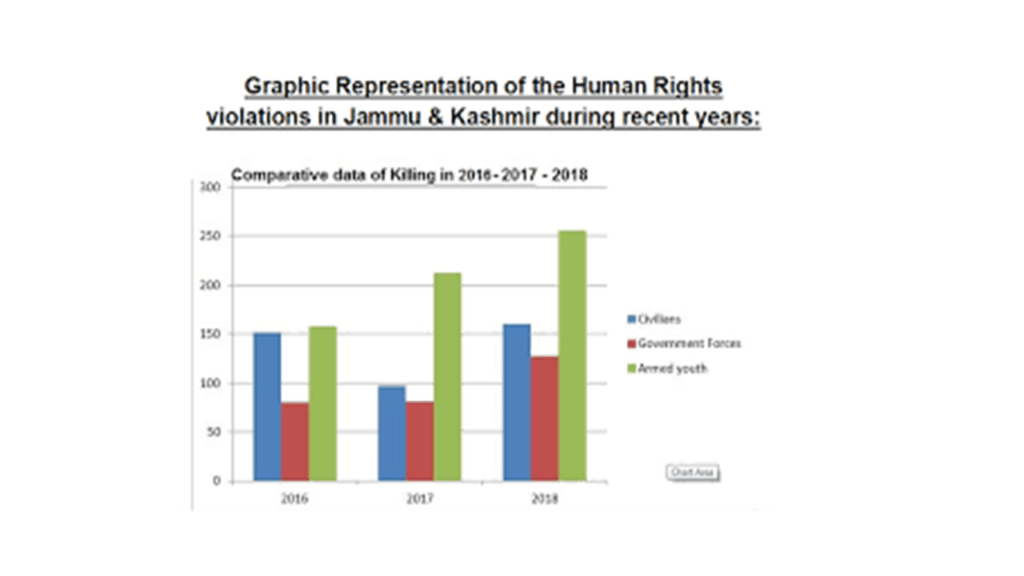
Figure 4: Kashmirian’s killed showing evidence of human rights violation
(Source:[8])
Most recently in Lucknow, the people from Kashmir have been attacked. The terms like “human rights” and Geneva Convention” were of late very often being pronounced in the media world in relation to the attack on the Kashmir civilians.
Figure 3: Kasmirians being attacked in Lucknow
(Source: [9])
Atrocities on the untouchables or the so-called Dalits have sarcastically increased eight-fold in comparison to the records maintained in the last five years. 20,000 reported cases have emerged where criminal activities are largely being portrayed by journalists[10]. Beef related lynching that almost accumulated to about 25 deaths have been sarcastic and also heart wrenching. In 2017, the minister of the state has confirmed that there were about 111 deaths that took place from about 822 communal incidents where some have been reported while some left unreported. Lingraj Azad was considered as the latest victim who was protesting against the corporate giant Vedanta in Orissa. The human right provision that has been made in the last two years has been literally an abuse. In fact, the sarcasm started with the UN Human Rights Council warning India about the increased reports of attacks on the minorities.
Figure 4: Human Rights violation in India is even more tragic than Syria
(Source: [11])
Equality to Rights and Equality to Religious Beliefs” have only being a terminology by now since the recent outrageous activities on the Muslims and Dalits is a grim reminder on the unfair democratic rights on people of India[12]. The 2:1 judgment on the case scenario of Romila Thapar v. UOI[13], the Special Investigation Team has been forbidden to conduct the investigation further in the case related to adduction of the evidences by the state where the members are considered to be banned as terrorist activists[14]. The power of the Lieutenant Governor has also been under controversy as observed in the case-law of Government of NCT of Delhi v UOI[15]. The religious ban on the women from entering the temples during the days of menstruation has been decided in the case-law 4:1 of the Indian Young Lawyers Association v. State of Kerala[16]. Equality to live and enjoy as it is was determined in the case-law of Navtej Johar v. Union of India [17], that decided that unisex is allowed in India to reside with equal power and with prestige. Equality to Rights also entails the rights that are bestowed on the criminals even as human beings. However, recently in Goa, it has been published by the media that criminals have been assaulted and wrongly treated denying liberty and basic treatment as human beings.
Violation of the human rights have been seen as a quiet natural storm that now has been a part and parcel of the Indian government. Political backlash or the cases that go unreported shows that the government has failed to keep up with the privy of protecting the citizens and specially their human rights[18]. Even after the amendments enforced in the constitution and start of the 70 years of independence, Dalits have been found to suffer the most on the verge of Right to Equality[19]. The stark difference that was there in the society prevalent during the British Colonialism has been still evident today as well. From the report that has been presented by the National Crime records Bureau, Dalits are the worse sufferer like witnessing beatings, violence, rapes and injustice for matters on land disputes[20].
From 2012 to 2014, it has seen an increase in about 29% but in 2018 it has raised more. The suicide incident of Rohith Vemula who was a Dalit PhD student studying in Hyderabad Central University led to dozens of similar cases that has become outrageous in shape. Inhuman treatment of the Dalits has been a sham on the face of the constitution on the 70th independence.
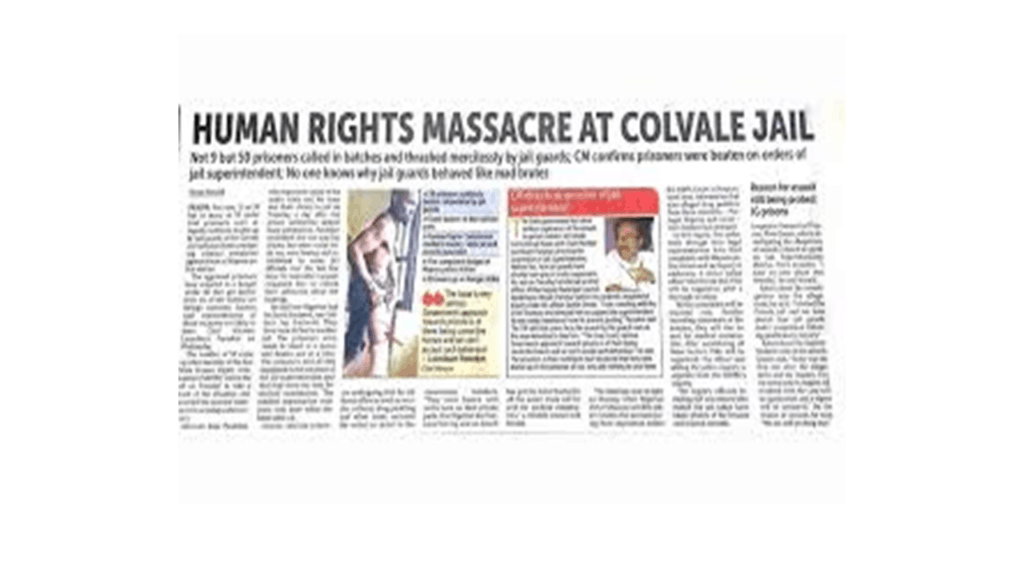
Figure 3: Massacre of human rights within the jail
(Source: [21])
It is being registered that every year, two out of eight children have been found to drop out of the school even before completing the eight standards. According to the report registered by AP State Commission for Protection of Child Rights (APSCPCR), it is stated that child right violation cases have been heard from Andhra Pradesh showing the failure of the protection of the Right to Education and Right against exploitation[22]. Section 3 of the Child Labour (Prohibition and Regulation) Amendment Act, 2016, it has been determined that children of the age below 14 will not be allowed to work. Numbers of laws have been passed under the constitution by preventing the children to be exposed to hazardous situation yet it has turned out to be an ultimate failure. In India, it has been reported that there are about 33 million of children still acting as labourers[23]. From the Census 2011, it has been estimated that there are about 80% of the children belonging from the Dalit classes and 20% are of the background classes. Therefore, the bitter truth cannot be ignored that people still are facing such sarcastic situation.
From this, it is evident that the laws framed are just a part of the story; the reality is something different creating a bigger darker picture making mockery of the fundamental rights. In Hashimpura locality situated in Meerut, 16 police officers have been blamed for massacring 40 Muslims. Again, in the same year, it was recorded that 20 people have been shot dead by the police official who were suspected of the smuggling activity in Telangana. However, these incidents clearly entail of what has been stated to be against the norms that have been set in the Freedom of Religion. Right to Freedom relates to the freedom of expression that is being accounted for and taken care by the governmental bodies. Two of the social activists were arrested in Kerala for promoting “Pro-Maoist” literature. From none of the angle, it has been reported that India has been really making the provisions work as framed by the Constitution.
Noorjehan v. State of Maharashtra[24], has been one of the renowned cases that have spoken about the ‘test for laws in force”[25]. The most sarcastic part that has evolved in the era of 2018 and 2019 has been that people have been now found fighting for the rights. The rights are being naturally enforced by the law and this has changed the viewpoint of the people living in the 21st century. Both regressive and adverse attitude has been evidence in the current era where every action seems to be against the constitution. It has been seen in the recent era that many cases have been filed against the people who have not committed any crimes and this has raised a question on the human rights as framed by the constitution. Mob lynching has been the violation to the right to life and this has been a mockery on behalf of the constitution.
I.IV ROLE OF JUDICIARY:
The Judiciary has the most important role to play in the protection of the human rights and protect the citizens under any circumstances[26]. For the human rights cases, the judiciary is considered as the most essential pillar and the guardian of the people. People’s Union for Civil Liberties (PUCL) v. Union of India[27], has been the case-law where the Supreme Court has saved children from being exposed to slavery and also taken care of the fact that child labour is not practiced anymore[28]. Regardless of the nationality and the sexuality, it is being considered that everyone has the right to live with prosperity.
The modern human rights have its baseline in the Universal Declaration of Human Rights (UDHR). Salal project v. State of Jammu and Kashmir[29], has been the case-law that has shown about the role of the judiciary intervening with the child labor problems. Judiciary has been found to play a crucial role in protecting the human rights and expanding the scope as well. The judiciary is constantly trying to take care of the well-being of the children as seen in the case-law of Bandhua Mukti Morcha v. Union of India[30].
The violations that are committed against the children, women, Dalits, Muslims or people from any other background have been quite unique where the judiciary is enforcing to take care of each cases. Judiciary being an independent part of the government specialized in creating remedies for the people. Habeas Corpus states grounds on which criminals or the arrested individual is given justice. To judicially review the issues or the cases have been endowed to the Supreme Court. Judicial Activism has been the scenario where the Court dynamically reviews the provision and then gives the necessary opinions through the framing of the Public Interest Litigation. Judicial Activism moves forward to change the society like in the case study of Air India v. Nergesh Meerza[31].
Kesavananda Bharti v. State of Kerala[32], has been the case-law that has formed to be the landmark decision in the Supreme Court where it has outlined the basic structure. By interpreting the laws, it has been established that the judiciary will play a crucial role[33]. Human rights and the protection of the human rights is critically being reviewed to be interrelated with media. Media has a bigger role to play in administering the activities that are being carried out in the society. Media has been acting as the watchdog that has been continuously ensuring to let the world know of the different allegations and the violations taking place. Contrary to the footages of the media showing of the violations, the government is also getting updated of the various crimes that are taking place. Different articles under the Constitution have spoken about the Rights and enshrined of the purpose behind the freedoms[34]. The Right to life and Liberty has been discussed broadly decades ago with the interpretation of the F. C. Mullin v. The Administrator, Union Territory of Delhi & others (1981 2 SCR 516)[35]. A. K. Gopalan v. State of Madras (AIR 1950 SC 27), has been the evidence of the case-law that has broadened the scope and let the Court review Article 21.
I.V HUMAN DEVELOPMENT AND SECURITY:
Article 37 to 50 has clearly entitled the Right to Development of people as citizens of India where the state will take care of the matter in relation to the well-being of the people[36]. The Directive Principle has stated that every human being has the right to think of choosing the steps that will lead to development and give an assured future to the people. Right to Development in entangled with the concept where people think of their personal life and wishes to incur development through some strategies. It is considered by the Principles as one of the inalienable rights that will lead the people to fulfill their career and also get desired outcomes. In India, however, it is seen that children are mostly encouraged to take part in educational activities that will give them the platform to seek development[37]. Development incurs with it the context of availability of foods and clothing to everyone that will show the bigger picture of development of India from the economic context[38].
Today, in India even in still parts the differences between the poor and the rich is a devastating picture that has brought question to the Right to Development. Development is possible when the society and the state works hand in hand to incur development and thus excels the scope for the people to embrace development. From the context of Economic, Social and Cultural Rights, it is ascertained that the government has the right to take care of the living standards of the people and make measures that will improve the lifestyles of the people without focusing on the differences between the rich and the poor. 1986 General Assembly Declaration has elaborated on the concept of the Right to Development. Right to Development can only be attained when the Right to Liberty, life and security of the person will be enriched and safeguarded.
Despite of the government enforcing freedom of expression there have been evidences of tortures where many have been jailed while some have been ruthlessly killed. It is seen that the Constitution despite giving such rights of managing the situation yet it is not so. Olga Tellis et. al. v. Bombay Municipal Corporation et. al.[39], the Right to Earn a Livelihood has brought questions to the different contexts such as that of development, security and freedom of life and liberty. It has been entangled that if the individual does not enjoy the freedom to security, development cannot be fostered. Hence, one need to recognize that the life is being secured then the person can think of development. Article 39(a) and 41 has stated that the Constitution should protect the rights to live and work so that they can have an enhanced performance in the society being a part of the society.
The case-law of Delhi Transport Corporation v. D.T.C. Mazdoor Congress[40], has highly spoken of the protection of life and security provision that is attached with the context of human development[41]. Unless and until an individual is secured with the Rights to Shelter, the person cannot think of the context of development as has been discussed in the case-law of Chameli Singh v. State of UP[42].
I.VI UDHR:
Universal Declaration of Human Rights (UDHR) has been termed as one of the greatest living documents that has been recognized as the common language to be considered for identifying the context of humanity. It can be also stated as the ‘conscience of the world’. India has significantly contributed to the concept of UDHR that has led the members of the Parliament and the Constitution think of the principles to be followed for human rights protection and enforcement[43]. UDHR was mainly drafted by the Commission of the Human Rights and was created by the Economic and Social Council of the United Nations in 1946. Hansa Mehta made a serious contribution to the UDHR that has been historically made known to all.
The themes that were concise in the UDHR have been the following:
- Right to Work
- Secularism, cosmopolitanism and others
- Non-Discrimination
- Women’s Rights
- Freedom of movement
From the above-discussed themes, it was clear that universally, the principles were to be followed by all and hence would lead to the protection of the people from any unfair terms and also legitimate them with the right to practice subjects that are not to be judged with discrimination or any unfair means[44]. Henceforth, the Universal Declaration of the Human Rights has kept in mind that human beings need to live in a flexible environment where they can breathe freely and move freely without being judged on their background or gender[45]. Global governance system was manifested that led India to stand up for the human rights and incur social justice.
I.VII CONCLUSION:
Human rights are acknowledged as those minimal rights that every individual must have irrespective of any consideration. The Constitution of India has the very essence of human rights in its Preamble and the Fundamental Rights and the Directive Principles of State Policy. The Constitution of India enshrines the list of fundamental rights and freedoms.
It has been universally recognised that right to life, liberty and dignity are inherent in the human nature. In spite of a proliferation of Declarations and Covenants on human rights, instances of their violation continue unabated.
References List:
- Ahmad, D., 2020. Analysis of the Human Rights Practice and Protection of the Human Rights in India. Available at SSRN 3559437.
- com (2017). India child abuse ‘every 15 minutes’. Available at: https://www.bbc.com/news/world-asia-india-42193533 (Accessed: 12 June 2020).
- Berti, D., 2016. Plaintiff Deities. Ritual Honours as Fundamental Rights in India. Filing Religion: State, Hinduism, and Courts of Law, pp.71-100.
- Choudhry, S., Khosla, M. and Mehta, P.B. eds., 2016. The Oxford handbook of the Indian constitution. Oxford University Press.
- Dangwal, R.R., 2016. 37_Personal Liberty under the Constitution of India (1993).
- Fares, L., 2018. India: A Model for the Enforcement of Economic, Social, and Cultural Rights. JL & Com., 37, p.281.
- Fernando, S. and Nair, V.V., 2018. 70 years on: UN declaration on human rights from the lens of victimology.
- Gehlot, S., 2019. A RESEARCH AGENDA FOR THE PROTECTION OF WOMEN RIGHTS IN INDIA. Journal Current Science, 20(5).
- Ghosh, S., 2016. Democracy and human development: recent legislation in India. Development Policy Review, 34(4), pp.539-561.
- Haq, I., 2017. Conflict and Human Rights Violation: A Study of Kashmir Valley. Journal of South Asian Studies, 5(3), pp.117-125.
- Hasani, S.S., 2017. Judicial Activism and Fundamental Rights in India. Quest-The Journal of UGC-HRDC Nainital, 11(3), pp.224-227.
- in (2020). Human Rights In India: Role of Judiciary and Judicial Activism – Ignited Minds Journals. Available at: http://ignited.in/I/a/89690 (Accessed: 12 June 2020).
- Kumar, U., 2014. Erosion of faith in judicial system in India _ an evaluative study.
- Mehrotra, S., Kumra, N. and Gandhi, A., 2017. The Fragmented Social Protection System in India: Five Key Rights but Two Missing. In Towards Universal Health Care in Emerging Economies(pp. 297-319). Palgrave Macmillan, London.
- Morrow, V. and Singh, R., 2016. Understanding children’s experiences of violence in Andhra Pradesh and Telangana, India: Evidence from Young Lives.
- Niaz, N.S. and Apte, J.S., 2018. Muslim Women and Law Reforms: Concerns and Initiatives of the Excluded within the Excluded. In Lives of Muslims in India(pp. 250-271). Routledge India.
- Obulapathi, M. and Ramanjaneyulu, C., 2016. Violation of dalit human rights: The Indian experience. International journal of applied research, 2(3), pp.603-609.
- Prabhu, S., 2019. A STUDY ON HUMAN RIGHTS VIOLATIONS OF DALIT WOMEN WITH SPECIAL REFERENCE TO KARUR DISTRICT OF TAMIL NADU. Global Journal For Research Analysis, 8(5).
- Radhakrishnan, S. (2008) “Development of Human Rights in an Indian Context,” International Journal of Legal Information: Vol. 36: Iss. 2, Article 14
- Ray, S. (2016) On India’s 70th year of independence, here are some of the country’s worst human rights violations, com. Available at: https://yourstory.com/2016/12/on-indias-70th-year-of-independence-here-are-some-of-the-countrys-worst-human-rights-violations (Accessed: 12 June 2020). The Origin and Concept of Fundamental Rights in the Constitutions of US, UK and India: A Comparative Analysis
- Shah, P.H., 2019. Critical analysis on ‘Indian young lawyers association and ors. vs. state of Kerala and ORS’. ACADEMICIA: An International Multidisciplinary Research Journal, 9(2), pp.17-25.
- Shetty, S., (2019). Throwing Stones from Inside a Glass House – India’s Human Rights Record Since 2014 Available at: https://thewire.in/rights/india-human-rights-record-since-2014 (Accessed: 12 June 2020).
- Sikkink, K., 2019. Evidence for hope: Making human rights work in the 21st century(Vol. 28). Princeton University Press.
- Sripati, V., 2020. Human Rights in India-Fifty Years after Independence (1947-97). Denver Journal of International Law & Policy, 27(3), p.6.
- Stubbs, M., 2018. The universal declaration of human rights at 70. The Bulletin, 40(11), pp.2019-118.
- Suzuki, M., 2019. Justice and Human Rights at the Grassroots Level: Judicial Empowerment in Dalit Activism. In Law and Democracy in Contemporary India(pp. 169-189). Palgrave Macmillan, Cham.
- com (2020). A law that allows child labor. Available at: https://www.thehindu.com/opinion/columns/A-law-that-allows-child-labour/article14560563.ece (Accessed: 12 June 2020).
- the wire. (2020). Remembering India’s Contributions to the Universal Declaration of Human Rights. Available at: https://thewire.in/rights/indias-important-contributions-to-the-universal-declaration-of-human-rights (Accessed: 15 June 2020).
- in (2019). Outrage After Two Kashmiris Thrashed in Lucknow by ‘Saffron-Clad’ Group. Available at: https://thewire.in/rights/two-kashmiris-thrashed-in-lucknow-viral-video (Accessed: 12 June 2020).
- com. (2019). Human Rights violations in India are even more tragic than Syria: International think tank Report. Available at: https://timesofislamabad.com/10-Jan-2019/human-rights-violations-in-india-are-even-more-tragic-than-syria-international-think-tank-report (Accessed: 12 June 2020).
- Verma, A., 2017. Legislative genesis jurisprudence and implementation of the right of children to free and compulsory education act 2009 a socio legal study with special reference to state of Gujarat.
[1] Berti, D., 2016. Plaintiff Deities. Ritual Honours as Fundamental Rights in India. Filing Religion: State, Hinduism, and Courts of Law, pp.71-100.
[2] Sripati, V., 2020. Human Rights in India-Fifty Years after Independence (1947-97). Denver Journal of International Law & Policy, 27(3), p.6.
[3] Ahmad, D., 2020. Analysis of the Human Rights Practice and Protection of the Human Rights in India. Available at SSRN 3559437.
[4] Ibid.
[5] Ibid.
[6] Gehlot, S., 2019. A RESEARCH AGENDA FOR THE PROTECTION OF WOMEN RIGHTS IN INDIA. Journal Current Science, 20(5).
[7] bbc.com (2017). India child abuse ‘every 15 minutes’. Available at: https://www.bbc.com/news/world-asia-india-42193533 (Accessed: 12 June 2020).
[8] Haq, I., 2017. Conflict and Human Rights Violation: A Study of Kashmir Valley. Journal of South Asian Studies, 5(3), pp.117-125.
[9] Shetty, S., (2019). Throwing Stones From Inside a Glass House – India’s Human Rights Record Since 2014 Available at: https://thewire.in/rights/india-human-rights-record-since-2014 (Accessed: 12 June 2020).
[10] thewire.in (2019). Outrage After Two Kashmiris Thrashed in Lucknow by ‘Saffron-Clad’ Group. Available at: https://thewire.in/rights/two-kashmiris-thrashed-in-lucknow-viral-video (Accessed: 12 June 2020).
[11] timesofislamabad.com. (2019). Human Rights violations in India are even more tragic than Syria: International think tank Report. Available at: https://timesofislamabad.com/10-Jan-2019/human-rights-violations-in-india-are-even-more-tragic-than-syria-international-think-tank-report (Accessed: 12 June 2020).
[12] Hasani, S.S., 2017. Judicial Activism and Fundamental Rights in India. Quest-The Journal of UGC-HRDC Nainital, 11(3), pp.224-227.
[13] Writ Petition (CRIMINAL) No. 260 OF 2018
[14] Shetty, S., (2019). Throwing Stones from Inside a Glass House – India’s Human Rights Record Since 2014 Available at: https://thewire.in/rights/india-human-rights-record-since-2014 (Accessed: 12 June 2020).
[15](2018) 8 SCC 501
[16] Shah, P.H., 2019. Critical analysis on ‘Indian young lawyers association and ors. vs. state of Kerala and ORS’. ACADEMICIA: An International Multidisciplinary Research Journal, 9(2), pp.17-25.
[17] Writ Petition (CRIMINAL) NO. 76 OF 2016.
[18] Suzuki, M., 2019. Justice and Human Rights at the Grassroots Level: Judicial Empowerment in Dalit Activism. In Law and Democracy in Contemporary India (pp. 169-189). Palgrave Macmillan, Cham.
[19] Obulapathi, M. and Ramanjaneyulu, C., 2016. Violation of dalit human rights: The Indian experience. International journal of applied research, 2(3), pp.603-609.
[20] Prabhu, S., 2019. A STUDY ON HUMAN RIGHTS VIOLATIONS OF DALIT WOMEN WITH SPECIAL REFERENCE TO KARUR DISTRICT OF TAMIL NADU. Global Journal For Research Analysis, 8(5).
[21] Sikkink, K., 2019. Evidence for hope: Making human rights work in the 21st century (Vol. 28). Princeton University Press.
[22] 70th-year-of-independence-here-are-some-of-the-countrys-worst-human-rights-violations (Accessed: 12 June 2020). The Origin and Concept of Fundamental Rights in the Constitutions of US, UK and India: A Comparative Analysis.
[23] Morrow, V. and Singh, R., 2016. Understanding children’s experiences of violence in Andhra Pradesh and Telangana, India: Evidence from Young Lives.
[24] Public Interest Litigation No. 106 of 2014.
[25] Niaz, N.S. and Apte, J.S., 2018. Muslim Women and Law Reforms: Concerns and Initiatives of the Excluded within the Excluded. In Lives of Muslims in India (pp. 250-271). Routledge India.
[26] ignited.in (2020). Human Rights In India: Role of Judiciary and Judicial Activism – Ignited Minds Journals. Available at: http://ignited.in/I/a/89690 (Accessed: 12 June 2020).
[27] Writ petition (Civil) No. 196 of 2001.
[28] Fares, L., 2018. India: A Model for the Enforcement of Economic, Social, and Cultural Rights. JL & Com., 37, p.281.
[29] 1984 (1) SCALE 680, (1984) 3 SCC 538.
[30] 1984 AIR 802, 1984 SCR (2) 67.
[31] 1981 AIR 1829, 1982 SCR (1) 438.
[32] (Writ Petition (Civil) 135 of 1970).
[33] Verma, A., 2017. Legislative genesis jurisprudence and implementation of the right of children to free and compulsory education act 2009 a socio legal study with special reference to state of Gujarat.
[34] Dangwal, R.R., 2016. 37_Personal Liberty under the Constitution of India (1993).
[35] Choudhry, S., Khosla, M. and Mehta, P.B. eds., 2016. The Oxford handbook of the Indian constitution. Oxford University Press.
[36] Mehrotra, S., Kumra, N. and Gandhi, A., 2017. The Fragmented Social Protection System in India: Five Key Rights but Two Missing. In Towards Universal Health Care in Emerging Economies (pp. 297-319). Palgrave Macmillan, London.
[37] Radhakrishnan, S. (2008) “Development of Human Rights in an Indian Context,” International Journal of Legal Information: Vol. 36: Iss. 2, Article 14.
[38] Ghosh, S., 2016. Democracy and human development: recent legislation in India. Development Policy Review, 34(4), pp.539-561.
[39] 1986 AIR 180, 1985 SCR Supl. (2) 51.
[40] 1991 AIR 101, 1990 SCR Supl. (1) 142
[41] Kumar, U., 2014. Erosion of faith in judicial system in India _ an evaluative study.
[42] Appeal (civil) 12122 of 1995.
[43] Stubbs, M., 2018. The universal declaration of human rights at 70. The Bulletin, 40(11), pp.2019-118.
[44] Fernando, S. and Nair, V.V., 2018. 70 years on: UN declaration on human rights from the lens of victimology.
[45] the wire. (2020). Remembering India’s Contributions to the Universal Declaration of Human Rights. Available at: https://thewire.in/rights/indias-important-contributions-to-the-universal-declaration-of-human-rights (Accessed: 15 June 2020).
